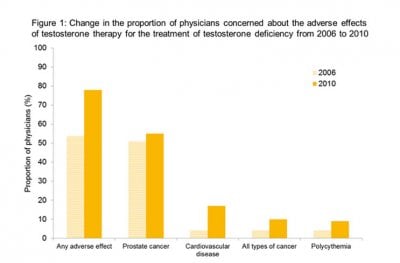Nelson Vergel
Founder, ExcelMale.com

Changes in the worldwide diagnosis and treatment of testosterone deficiency between 2006 and 2010Diagnosing and treating testosterone deficiency in different parts of the world: changes between 2006 and 2010. Gooren LJ, Behre HM. The Aging Male 2012;15(1):22-27.
Key Points
In 2010, the majority of physicians surveyed (82%) would regularly use laboratory measurements of total testosterone to diagnose testosterone deficiency and 17% of the physicians surveyed would measure total testosterone levels sometimes
Other laboratory measurements used to diagnose testosterone deficiency were free testosterone (32% regularly, 36% sometimes) and sex hormone binding globulin (29% regularly, 45% sometimes) levels
The proportion of physicians who would use laboratory measurements to diagnose testosterone deficiency in 2010 did not differ from 2006
Physicians consider the main symptoms of testosterone deficiency to be erectile dysfunction (ED; 53%), lack of libido (53%), fatigue (45%), loss of power (13%), depression (26%), weight gain (16%) and loss of hair/reduced body hair (16%)
There was an increased awareness among physicians of depression and weight gain as clinical symptoms of low testosterone
Similar to the original survey in 2006, for 70% of the physicians surveyed, the severity of the symptoms experienced was considered a more significant reason to start testosterone treatment than the laboratory value of testosterone
This was the case more so in Germany (96%), the United Kingdom (63%) and Brazil (62%) than in Saudi Arabia (36%) and Spain (7%), who relied more on testosterone measurements
In 2010, significantly more physicians expressed concern about the adverse effects of testosterone treatment compared with 2006 (78% vs 54%; Figure 1)
Many physicians remained concerned about prostate cancer (55% vs 51%)
Concerns about cardiovascular disease (17% vs 4%), risk of all types of cancer (10% vs 4%) and polycythemia (9% vs 4%) were also expressed
Eleven percent of patients eligible for testosterone therapy did not receive treatment due to these concerns.
The patterns of prescribing testosterone for short term or longer term treatment did not change from 2006 to 2010
Lifelong treatment with parenteral testosterone undecanoate was intended in 33% of patients, whereas 67% of patients used the treatment for a limited time (10–48 months)
Duration of treatment was shorter in patients receiving testosterone gel compared with those receiving testosterone undecanoate injections
The proportion of patients diagnosed with ED who have testosterone deficiency ranged from 41% to 64% depending on the country
These patients were more likely in 2010 to be treated with phosphodiesterase type 5 (PDE5) inhibitor monotherapy or testosterone + PDE5 inhibitors than in 2006
Furthermore, there was great variation between countries with regards to the treatments utilized for ED in patients with testosterone deficiency
In Saudi Arabia, Spain and the United Kingdom, the use of testosterone + PDE5 inhibitors is increasing
In comparison, in Germany, PDE5 inhibitor monotherapy is utilized more.















